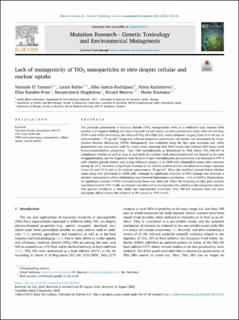| dc.contributor.author | El Yamani, Naouale | |
| dc.contributor.author | Rubio, Laura | |
| dc.contributor.author | García-Rodríguez, Alba | |
| dc.contributor.author | Kažimírová, Alena | |
| dc.contributor.author | Rundén-Pran, Elise | |
| dc.contributor.author | Barančoková, Magdaléna | |
| dc.contributor.author | Marcos, Ricard | |
| dc.contributor.author | Dusinska, Maria | |
| dc.date.accessioned | 2022-10-10T12:10:51Z | |
| dc.date.available | 2022-10-10T12:10:51Z | |
| dc.date.created | 2022-09-27T13:38:57Z | |
| dc.date.issued | 2022 | |
| dc.identifier.citation | Mutation Research. Genetic Toxicology and Environmental Mutagenesis. 2022, 882, 503545. | en_US |
| dc.identifier.issn | 1383-5718 | |
| dc.identifier.uri | https://hdl.handle.net/11250/3025111 | |
| dc.description.abstract | The potential genotoxicity of titanium dioxide (TiO2) nanoparticles (NPs) is a conflictive topic because both positive and negative findings have been reported. To add clarity, we have carried out a study with two cell lines (V79–4 and A549) to evaluate the effects of TiO2 NPs (NM-101), with a diameter ranging from 15 to 60 nm, at concentrations 1–75 μg/cm2. Using two different dispersion procedures, cell uptake was determined by Transmission Electron Microscopy (TEM). Mutagenicity was evaluated using the Hprt gene mutation test, while genotoxicity was determined with the comet assay, detecting both DNA breaks and oxidized DNA bases (with formamidopyrimidine glycosylase - Fpg). Cell internalization, as determined by TEM, shows TiO2 NM-101 in cytoplasmic vesicles, as well as close to and inside the nucleus. Such internalization did not depend on the state of agglomeration, nor the dispersion used. In spite of such internalization, no cytotoxicity was detected in V79–4 cells (relative growth activity and plating efficiency assays) or in A549 cells (AlamarBlue assay) after exposure lasting for 24 h. However, a significant decrease in the relative growth activity was detected at longer exposure times (48 and 72 h) and at the highest concentration 75 µg/cm2. When the modified enzyme-linked alkaline comet assay was performed on A549 cells, although no significant induction of DNA damage was detected, a positive concentration-effects relationship was observed (Spearman’s correlation = 0.9, p 0.0001). Furthermore, no significant increase of DNA oxidized purine bases was observed. When the frequency of Hprt gene mutants was determined in V79–4 cells, no increase was observed in the exposed cells, relative to the unexposed cultures. Our general conclusion is that, under our experimental conditions, TiO2 NM-101 exposure does not exert mutagenic effects despite the evidence of NP uptake by V79–4 cells. | en_US |
| dc.language.iso | eng | en_US |
| dc.rights | Navngivelse 4.0 Internasjonal | * |
| dc.rights.uri | http://creativecommons.org/licenses/by/4.0/deed.no | * |
| dc.title | Lack of mutagenicity of TiO2 nanoparticles in vitro despite cellular and nuclear uptake | en_US |
| dc.title.alternative | Lack of mutagenicity of TiO2 nanoparticles in vitro despite cellular and nuclear uptake | en_US |
| dc.title.alternative | Lack of mutagenicity of TiO<inf>2</inf> nanoparticles in vitro despite cellular and nuclear uptake | en_US |
| dc.type | Peer reviewed | en_US |
| dc.type | Journal article | en_US |
| dc.description.version | publishedVersion | en_US |
| dc.rights.holder | © 2022 The Authors. Published by Elsevier B.V. | en_US |
| dc.source.volume | 882 | en_US |
| dc.source.journal | Mutation Research. Genetic Toxicology and Environmental Mutagenesis | en_US |
| dc.identifier.doi | 10.1016/j.mrgentox.2022.503545 | |
| dc.identifier.cristin | 2055915 | |
| dc.relation.project | EC/H2020/857381 | en_US |
| dc.relation.project | EC/H2020/814572 | en_US |
| dc.relation.project | EC/H2020/801370 | en_US |
| dc.relation.project | EC/H2020/814425 | en_US |
| dc.relation.project | EC/H2020/101008099 | en_US |
| dc.relation.project | EC/H2020/646221 | en_US |
| dc.relation.project | Norges forskningsråd: 239199 | en_US |
| dc.relation.project | EC/FP7/NMP4-LA-2013-310584 | en_US |
| dc.relation.project | EC/H2020/952404 | en_US |
| dc.source.articlenumber | 503545 | en_US |
| cristin.ispublished | true | |
| cristin.fulltext | original | |
| cristin.qualitycode | 1 | |

